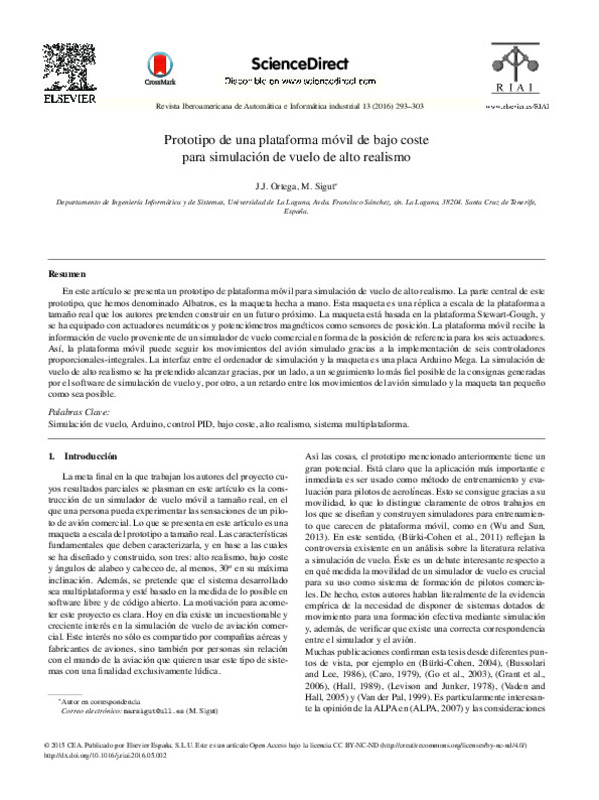Air Line Pilots Association (ALPA), 2007. Safety Committee Statement of Position: The Need for Motion in Flight Simulation.
Álvarez, C., Saltaren, R., Aracil, R., García, C., 2009. Concepcion, desarrollo y avances en el control de navegación de robots submarinos paralelos: El robot Remo-I. Revista Iberoamericana de Automatica e Informatica Industrial 6(3), 92-100.
Ames Technology Capabilities and Facilities. 2008. VMS - Vertical Motion Simulator. Recuperado de http://www.nasa.gov/ centers/ames/research/ technology-onepagers/vms.html.
[+]
Air Line Pilots Association (ALPA), 2007. Safety Committee Statement of Position: The Need for Motion in Flight Simulation.
Álvarez, C., Saltaren, R., Aracil, R., García, C., 2009. Concepcion, desarrollo y avances en el control de navegación de robots submarinos paralelos: El robot Remo-I. Revista Iberoamericana de Automatica e Informatica Industrial 6(3), 92-100.
Ames Technology Capabilities and Facilities. 2008. VMS - Vertical Motion Simulator. Recuperado de http://www.nasa.gov/ centers/ames/research/ technology-onepagers/vms.html.
AMST. (2015). Desdemona - The revolution in simulation. Recuperado de http://www.amst.co.at/en/training-simulation-products/desdemona/.
Arai, S., Kondo, H., Goto, H., Tanaka, Y., 2012. Evaluation of motion with washout algorithm for flight simulator using tripod parallel mechanism. In Proc. of the 19th International Conference Mechatronics and Machine Vision in Practice, Auckland.
Bellmann, T., Heindl, J., Hellerer, M., Kuchar, R., Sharma, K., Hirzinger, G., 2011. The DLR robot motion simulator Part I: Design and setup. In Proc. of IEEE International Conference on Robotics and Automation, Shanghai.
Burki-Cohen, J., Go, T.H., Chung, W.W., Schroeder, J., 2004. Simulator platform motion requirements for recurrent airline pilot training and evaluation, Final Report.
Burki-Cohen, J., Sparko, A.L., Bellman, M., 2011. Flight simulator motion literature pertinent to airline-pilot recurrent training and evaluation. In Proc. of AIAA Modeling and Simulation Technologies Conference, Portland.
Bussolari, S.R., Lee, A.T., 1986. The effects of flight simulator motion on pilot performance and simulator acceptability in transport category aircraft. Massachusetts Institute of Technology/NASA Ames Research Center.
Caro, P.W., 1979. The relationship between flight simulator motion and training requirements. Human Factors 4, 493-501.
Chunping, P., Ying, L., Jianmin, L., Yongjun, G., 2012. A time varying washout approach for flight simulation hexapod motion system. In Proc. of IEEE International Conference on Computer Science and Automation Engineering, Zhangjiajie.
FlightSafety International. (2015). FlightSafety Simulators and Training Technology. Recuperado de http://www.flightsafety.com/ fs simulation landing.php.
Go, T.H., Burki-Cohen, ¨ J., Chung, W.W., Schroeder, J., Saillant, G., Jacobs, S., Longridge, T., 2003. The effects of enhanced hexapod motion on airline pilot recurrent training and evaluation. In Proc. of AIAA Modeling and Simulation Technologies Conference, Austin.
Grant, P.R., Yam, B., Hosman, R., Schroeder, J.A., 2006. Effect of simulator motion on pilot behavior and perception. J. Aircr. 43(6), 1914-1924.
Hall, J.R., 1989. The need for platform motion in modern piloted flight training simulators. In Royal Aerospace Establishment, Tech Memo FM 35, Bedford.
Hitaka, Y., Tanaka, Y., Ichiryu, K., 2009. Motion analysis of tripod parallel mechanism. Artif. Life and Robot. 14(4), 494-497.
Izaguirre, E., Hernández, L., Rubio, E., Prieto, P.J., Hernandez, ' A., 2011. Control desacoplado de plataforma neumática de 3-GDL utilizada como simulador de movimiento. Revista Iberoamericana de Automatica e Informatica Industrial 8(4), 345-356.
Kent, J.L., 2010. Limits on human perception, in: Psychedelic information theory. Shamanish in the age of reason. PIT Press / Supermassive, LLC, Seattle WA, pp. 37-48.
Levison, W.H., Junker, A.M., 1978. A model for the pilot's use of motion cues in steady-state roll-axis tracking tasks. In Proc. of AIAA Flight Simulation Technologies Conference, Arlington.
National Aeronautics and Space Administration. (2014). CVSRF Advanced Concepts Flight Simulator. Recuperado de http://www.aviationsystemsdivision.arc.nasa.gov/ facilities/ cvsrf/ acfs.shtml.
Pradipta, J., Klunder, M., Weickgenannt, M., Sawodny, O., 2013. Development of a pneumatically driven flight simulator stewart platform using motion and force control. In Proc. of International Conference on Advanced Intelligent Mechatronics, Wollongong, NSW.
Regional Airline Association (RAA), 2008. Government research indicates simulator motion adds training complexity - RAA Recommends Operational Testing to Validate Effectiveness of Non-Motion Platforms, Regional Airline Industry White Paper.
Shiga, Y., Tanaka, Y., Goto, H., Takeda, H., 2011. Design of a six degree-offreedom tripod parallel mechanism for flight simulators. Int. J. Automation Technol. 5(5), 715-721.
Sung-Hua, Ch., Li-Chen, F., 2011. An optimal washout filter design with fuzzy compensation for a motion platform. In Proc. of the 18th IFAC World Congress, Milano.
Vaden, E.A., Hall, S., 2005. The effect of simulator platform motion on pilot training transfer: A meta-analysis, Int. J. Aviat. Psychology 15(4), 375-393.
Van der Pal, J., 1999. The effect of simulator motion on parameter training for F-16 pilots, engineering psychology and cognitive ergonomics: transportation systems, medical ergonomics and training. Edited by D. Harris, Ashgate, Oxford, England, pp. 267-275.
Van Heerden, A., Lidbetter, R., Liebenberg, L., Mathews, E.H., Meyer, J.P., 2011. Development of a motion platform for an educational flight simulator. Int. J. of Mechanical Engineering Education 39(4), 306-322.
Woodrow, P.M., Tischler, M.B., Hagerott, S.G., Mendoza, G.E., 2013. Low cost flight-test platform to demonstrate flight dynamics concepts using frequency-domain system identification methods. In Proc. of AIAA Atmospheric Flight Mechanics Education Conference, Boston.
Wu, L., Sun, Y.P., 2013. Development of a low-cost flight simulation training device for research and education. In Proc. of the 2nd International Conference on Intelligent Technologies and Engineering Systems, Kaohsiung, Taiwan.
[-]








